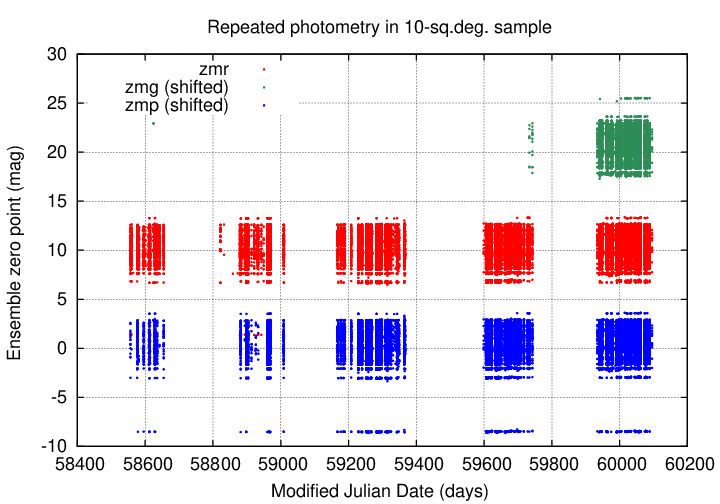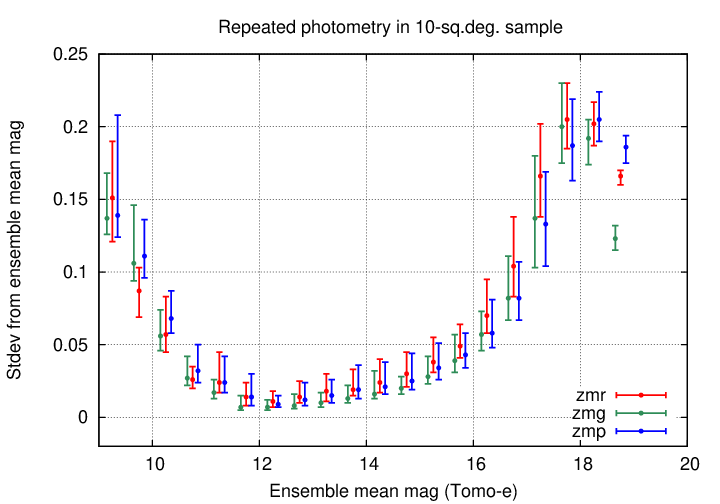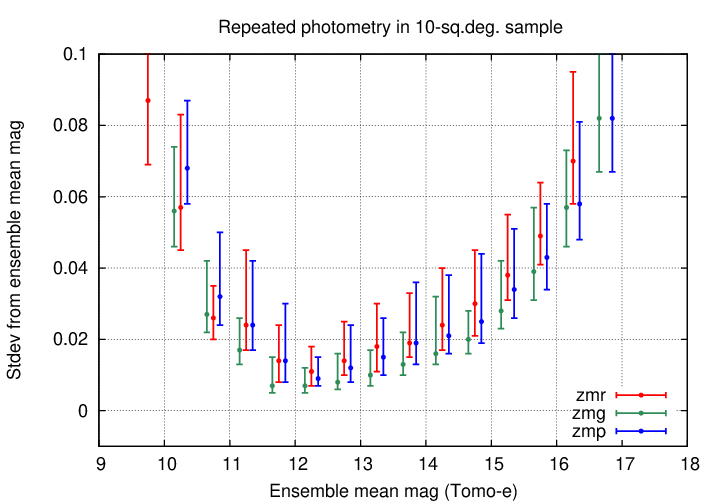
The source_stack table contains a large number of magnitude measurements for each detection. In this note, I compare the scatter in repeated measurements of objects in a small region for three particular choices of calibrated magnitude: magauto_zmr, magauto_zmg, magauto_zmp. I find that the first option yields many more measurements from the database than the others in this region. The scatter in repeated measurements is slightly higher in magauto_zmr, but not by a significant amount. I recommend concentrating on this magnitude for future study.
The source_stacked table contains many different varieties of calibrated magnitudes for each detected object. All start with instrumental magnitudes measured by SExtractor in a cleaned Tomo-e FITS image. The instrumental quantities are then converted into calibrated magnitudes following three main paths.
If any of the required reference measurements are missing, the Tomo-e software will simply fail to place a particular magnitude into the source_stack table. For example, if in some image, there are too few stars with good PS1 i-band measurements, the stars in that image will have no zmp magnitudes. Thus, we expect there to be more entries of _zmr values in the table, because there are more reference stars with only r-band measurements than reference stars with g-band, r-band, and i-band measurements.
Moreover, the Gaia EDR3 catalog was released on Dec 3, 2020, and likely was not adopted for use in the Tomo-e software until some time later. If (as I think likely) Tomo-e images were cleaned and measured a short time after being acquired, then all measurements before 2020 will be missing all zmg magnitudes. In fact, as we will see shortly, there are no zmg magnitudes in source_stack before late 2022.
In order to speed up the calculations, I restricted this comparitive study to a relatively small region on the sky: a 3-by-3 degree region centered on RA = 180, Dec = +5. I divided the region into "patches" of size 0.25 degrees on a side, each of which was analyzed as an ensemble. There were 156 patches in this area.
The figure below shows the time coverage of measurements in the source_stack table. Note that the magnitudes based on Pan-STARRS cover the entire span of the SN Survey, from 2019 through 2023, but those based on Gaia start to appear only in late 2022.

The table below compares the number of distinct stars included in the ensemble output, and the number of measurements of all those stars, for each variety of magnitude.
Magnitude Number of stars Number of measurements
------------------------------------------------------------------------
magauto_zmr 11,309 6,552,385
magauto_zmp 11,077 2,813,178
magauto_zmg 7,358 652,303
------------------------------------------------------------------------
The magauto_zmr dataset is by far the largest, and the magauto_zmg dataset by far the smallest.
One of the results of ensemble analysis is a measurement of the mean magnitude of each star after adjustments for zero-point offsets for each epoch, and the standard deviation from the mean of its measurements after those corrections. Let's see how the sigma-vs-mag relationships for the three different varieties of magnitude compare to each other.

To first order, all three versions of magnitude yield a very similar relationship, and so we have no strong reason for preferring one to another.
If we zoom in to examine the stars with smallest standard deviation, representing those with highest precision, we can see small differences between the varieties.

First, it appears that the zmg dataset has the smallest scatter. One reason, probably the major reason, for this (slightly) higher precision is the shorter time span of the measurements. The overall system -- telescope plus sensors plus atmosphere -- has undergone fewer changes in the short period covered by the zmg measurements, and so we should expect fewer systematic errors which would contribute to the scatter among the brightest stars.
Second, we see that the scatter in zmp is slightly smaller than that in zmr, at faint magnitudes especially; however, the difference is not very significant. The reference stars used to calibrated the zmp values must have, on average, slightly better photometric measurements, since they must be detected in all three PS1 passbands, while the zmr values can be produced if there is a detection only in the PS1 r-band. With a set of slightly better reference stars, the zmp values should be a little bit better.
Overall, however, the differences between the precision of the measurements is very small. I think that the best dataset to use is the zmr one, because it covers the entire timespan of the SN Survey, and it contains the largest number of measurements.